Physical Address
304 North Cardinal St.
Dorchester Center, MA 02124
The craniofacial structures have the formidable task of protecting the brain, the soft tissues that form the upper aerodigestive tracts, and the tissues vital to the special senses of vision, smell, taste, and hearing. Injury to the craniofacial region may therefore have devastating implications to the traumatized patient. Prompt and accurate diagnosis of craniofacial injuries is necessary for appropriate treatment to minimize both functional and aesthetic sequelae.
The epidemiology of craniomaxillofacial trauma varies greatly with the population being studied.
Differences are best explained by rates of motor vehicle usage, seat-belt laws, violent crime, and different kinds of leisure activities between groups in various geographic locations. However, certain epidemiologic principles regarding craniomaxillofacial trauma are relatively constant across most studied groups.
Taken as a group, males sustain skull or facial trauma considerably more frequently than females (approximately 3 : 1), with ratios approaching 8.2 and 9.5 in sport-related injuries and interpersonal violence, respectively.
The incidence of facial trauma tends to be higher in the risk-taking, mid-teenage years through the end of the third decade compared with childhood or mid-adulthood. Beyond the third decade, the incidence of injury declines until the elderly years, when strokes and age-related reductions in coordination lead to a second peak predominantly due to falls. Incidence of facial trauma peaks in the spring (April through June in a Northern Hemisphere series) and on weekends.
The major causes of facial injury include motor vehicle accidents (especially among cyclists), violent assault, falls, and sports-related injuries. Work-related trauma and animal attacks account for a relatively small percentage of cases of facial trauma worldwide. Somewhat surprisingly, alcohol intoxication is documented in a minority of cases (approximately 15% in one European series ), although investigators do suggest that such a low number may indicate poor documentation or failure to recognize intoxication in unconscious patients. It is worth noting that there is a high co-incidence of brain injury with facial trauma; one Canadian series found that brain injury is seen in two thirds of patients with facial fractures, with major brain injury seen in just under half of those cases. Therefore, detection of significant facial injury may warrant assessment of the brain as well, if that has not been performed at the same time as facial imaging.
A comprehensive discussion of the anatomy of the skull and facial vault is beyond the scope of this overview. However, when considering facial trauma, it is useful to review the concept of the facial buttresses ( eFig. 3-1 and see ). The support system of the facial skeleton can be thought of as a lattice of crisscrossing structures. Each individual structure by itself is relatively weak, but together the lattice offers significant resistance to compression and shearing forces. Failure of the lattice (i.e., a fracture) results in significant absorption and redistribution of mechanical energy, largely shielding the airway and brain from transmitted force in all but the most severe of cases.
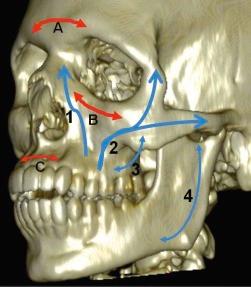
The horizontal (axial) struts of the face include (1) the orbital roof, including the frontal bar (the thickened segment of frontal bone between the two zygomaticofrontal sutures forming the superior orbital rims); (2) the orbital floors, including the more robust inferior orbital rims; and (3) the hard palate and especially the more robust maxillary alveolus anteriorly. The mandibular symphysis and parasymphysis are occasionally considered segments of a fourth caudal horizontal strut, but the relatively independent motion of the mandible renders it susceptible to trauma even in the absence of midfacial injury.
The vertical (sagittal) struts are nearly parallel, although they converge slightly at their superior aspects. The lateral (zygomaticomaxillary) buttress extends from the lateral maxillary alveolus along the zygoma to the lateral orbital rim at the zygomaticofrontal suture. The medial (nasomaxillary) facial buttress runs from the anterior maxillary alveolus along the piriform aperture of the nose and frontal process of the maxilla to the glabella of the frontal bone. The midline nasal septum is regarded by some as representing the third vertical component, but this is ordinarily thin and is frequently deformed or deviated so that it likely contributes little to overall facial stability.
The struts in the coronal plane offer the least resistance to facial compression, although they do aid in integrating or distributing force between two or more of the perpendicular struts to which they articulate. Anterior walls of the maxillary sinuses, which are frequently fractured in moderate to severe facial trauma, transmit secondary force to the zygomaticomaxillary, nasomaxillary, and orbital floor structures. The posterior buttress runs from the posterior maxillary alveolus along the posterior wall of the maxillary sinus to the pterygoid processes of the sphenoid bone; injury to this segment is ordinarily associated with other severe midfacial injury, for which the interpreter should search if more anterior structures appear spared initially. Some authors will also include the ascending ramus of the mandible as a fourth vertical buttress.
The integrity of the buttress system is of great importance in the structural support of the face. Accordingly, a primary goal of maxillofacial surgery in facial trauma is the restoration of proper alignment and adequate fixation of the significantly displaced facial buttresses. However, repair may be delayed or deferred if strut injury confers little or no functional or cosmetic deficit.
Nasal fractures are the most common of all facial fractures, in part because of the central prominent location of the nose, as well as the relatively small force required to fracture the region. The pattern of nasal fracture is highly dependent on the vector of force applied to the nose. Fracture may involve the bony or cartilaginous elements of the nose, but it often involves both.
The paired nasal bones join at the midline. The thicker upper portion of the nasal bone, which articulates with the frontal bone and frontal processes of the maxillae, is more resistant to fracture than is the thinner, broader inferior portion ( Fig. 3-1 ; see also eFig 3-2 ). The quadrangular cartilaginous nasal septum, which attaches to the perpendicular plate of the ethmoid bone posterosuperiorly and vomer posteroinferiorly, may also fracture, being more prone to injury in its thinner dorsal aspect. Although the diagnosis of nasal fracture can be made with both conventional lateral radiography of the nose and CT, multiple studies have demonstrated that nasal imaging is of little use in simple nasal fracture, because diagnosis can usually be made on clinical grounds. However, soft tissue swelling over a nasal fracture might make the fracture less conspicuous to the clinician, particularly in those fractures that are minimally displaced. In those cases, what may be interpreted as swelling may mask a clinically subtle nasal fracture. When this possibility is detected, the clinician should be alerted.
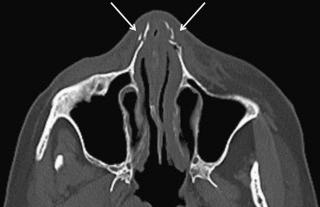
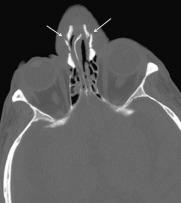
Four categories of orbital fracture are recognized: internal (blowout) fractures, orbital rim fractures, naso-orbito-ethmoid (NOE) fractures, and zygomatico-orbital (zygomaticomaxillary complex) fractures.
Orbital blowout fractures, by definition, involve the orbital walls and grossly spare the more robust orbital rims. When an object larger than the diameter of the orbital rim strikes the orbit, forces are absorbed by bone as well as the globe itself. Direct force to the osseous rim propagates rapidly in the first wave, resulting in subtle fragmentation of the struts to which the rim attaches. Of these struts, the inferior and medial orbital walls appear to be the weakest, given the frequency with which they are involved. Thus, fracture of these struts results in significant dissipation of force, but this initial wave fails to displace these fracture fragments significantly. The delayed recoil of the compressed globe, also vulnerable because it protrudes slightly beyond the orbital rim, causes a second soft tissue pressure wave. This force is transmitted through the periphery of the globe into the adjacent fat and to the bone, ultimately causing the displacement of the fracture fragments that is characteristically noted on imaging ( Fig. 3-2 ; see also eFig 3-3 ). Characteristic points of weakness include the portion of the floor formed by the orbital plate of the maxilla near the infraorbital groove, as well as the medial wall, which is formed by the thin lamina papyracea. In some series, the orbital floor variety is reported as the most common type, whereas in other series the medial wall variety is more frequent. Orbital roof and lateral orbital wall fractures are uncommon.
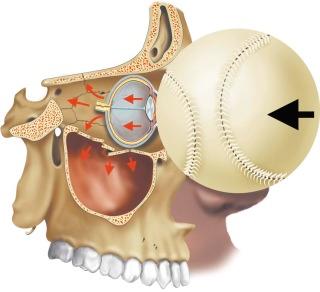
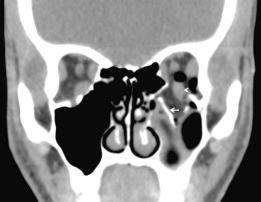
Intraorbital fat and extraocular muscle (typically the inferior rectus) may herniate through an orbital floor fracture defect, clinically resulting in diplopia. It is important to note that muscle itself need not herniate to cause entrapment; there exist significant fibrous septations running between fat and muscle, and therefore herniation of the tethered fat alone can lead to significantly restricted motion of the adjacent muscle. Orbital emphysema likely results not simply from disruption of the common sinus/orbital wall but rather in sinus wall fracture combined with the increased intranasal pressure the patient effects by blowing the nose to clear epistaxis ( Figs. 3-3 and 3-4 ; see also eFig 3-4 ).
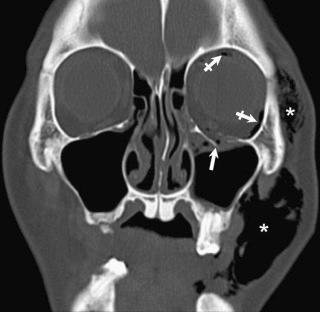
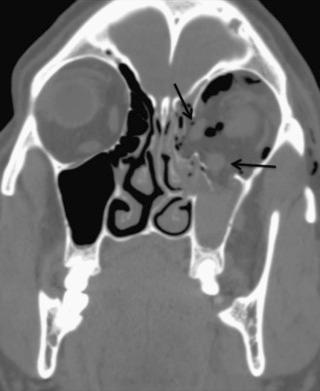
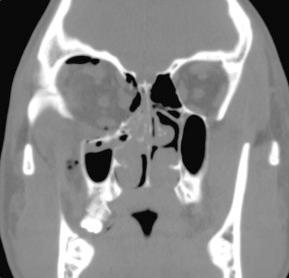
This increased pressure secondarily forces air into the adjacent fat. Such air may compensate for the orbital volume lost with fat herniation, so its detection is important in planning for surgery to prevent delayed enophthalmos in those patients without orbital dysfunction in whom surgery may not have been considered initially. Currently most centers with multidetector scanners appear to be assessing blowout fractures using thin-section axial imaging and high-quality reformatted images in the coronal and possibly oblique sagittal planes.
Blowout fractures may be treated operatively or conservatively. The goal of surgical intervention is to release entrapment, when present, as well as to restore normal orbital volume. In addition, because most patients with orbital floor blowout injuries develop some degree of inferior orbital and superior alveolar nerve hypoesthesia, early nerve decompression may also be crucial if the neural canal is compromised.
Developmental dehiscence of the lamina papyracea may simulate a medial blowout fracture ( Fig. 3-5 ). In this variant a segment of the medial orbital wall is bowed toward the ethmoid complex, with the medial extraconal fat (and sometimes a thickened medial rectus) herniating through the defect. Whereas the posterior margin of dehiscence is typically the basal lamella, the anterior extent may vary. Unlike in acute fractures, in which one may see density in sinuses reflecting hemorrhage, in dehiscence there is ordinarily no opacification of adjacent cells; however, because mucosal disease can opacify any of the sinuses with variably dense material, radiologic distinction of sinus inflammation from acute trauma may be difficult in cases of dehiscence. Furthermore, because ancillary soft tissue findings are lacking in chronic medial wall fractures, distinction of chronic injury from dehiscence may also be problematic. Although not reliably seen, the presence of an extra layer of bone just medial to the orbital fat would suggest prior fracture rather than dehiscence.
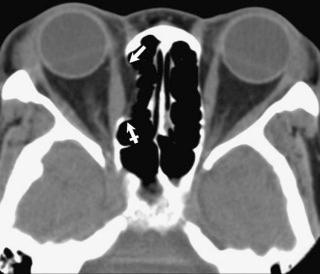
Orbital rim fractures typically result from direct impact to the orbital rim by a blunt object traveling at high velocity. Fractures may involve the superior, lateral, or inferior rims. In a superior rim fracture (the most common) the globe is displaced inferiorly and frequently anteriorly as well; associated edema and orbital or subperiosteal hemorrhage may exacerbate globe displacement ( Fig. 3-6 ). Deep projection of an osseous fragment into the orbit may cause frank rupture of the globe; because imaging studies may not detect mild scleral disruption, the determination of globe rupture is best made by direct ophthalmologic evaluation. In cases in which there has been subperiosteal bleeding, failure to drain a hematoma early may allow it to organize and ossify, resulting in permanent displacement of the globe with diplopia. Because fracturing the orbital rim requires great force, other osseous and soft tissue injuries are common.
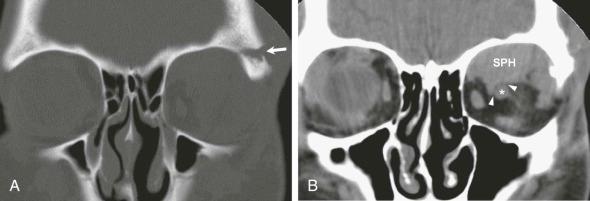
In particular, the studies must be carefully searched for contusions or shearing injury to the brain, epidural hematomas, or cerebrospinal fluid leaks. These leaks, which result from tearing of arachnoid and dura and which may appear days to years after the trauma, are important to identify because they increase the risk for meningitis.
Become a Clinical Tree membership for Full access and enjoy Unlimited articles
If you are a member. Log in here